Executive Summary
On July 5th, 2016, the Women’s Rights Policy Group1 brought together 50 civil society and government representatives for a full-day dialogue. Its goals were to develop a common understanding of feminist approaches to international assistance, to assess the challenges, gaps and opportunities in Global Affairs Canada’s approach, and to develop a set of practical recommendations for implementing a feminist approach. The recommendations presented in this brief are informed by that dialogue, and by the authors’ longstanding experiences with feminist policy and programming.
Key recommendations include:
- Begin all international assistance decision making with the fundamental question: how does this initiative address power and structural barriers to gender equality?
- Ensure that 20 percent of all aid investments have as their principal focus advancing women’s rights, women’s empowerment and gender equality. As part of this, dedicate $100 million annually towards an explicit fund for long-term predictable support for feminist and women’s rights organizations and movements.
- Create a standalone thematic pillar that would operationalize feminist principles through targeted women’s rights and gender equality programming.
- Mainstream gender equality objectives throughout all policy and programs, with a commitment to ensure that all international development programming has at least one well-resourced intermediate level outcome that specifically addresses structural gender inequalities.
- Develop mechanisms to ensure the application of a feminist approach is a necessary criterion for all international assistance.
Context and Rationale
Led by a feminist Prime Minister, and with a new commitment to a feminist approach to international assistance, Canada has an opportunity to become a global leader on women’s rights and gender equality. This is a game changer.
It’s about being bold in our ambition to move the needle forward. It’s about rethinking how we work and who we work with. It’s about walking the talk and ensuring that our financial commitments match our level of ambition.
This will not be easy. Inequality is entrenched globally, and patriarchal systems and attitudes are the norm. A cultural shift towards equality will require significant resources and time. The approach will have its critics, but a feminist approach has the power to truly transform societies.
Integrity and coherence are fundamental to feminist work. It is therefore difficult to look at a feminist approach to international assistance in isolation from a whole-of-government approach. Canada should ultimately adopt a feminist foreign policy that underpins its efforts and activities in international assistance, foreign relations, development and trade. For the purposes of this review process, this submission will focus on international assistance.
The timing could not be better. Women’s rights work is sorely underfunded worldwide – with Canada itself a below-average donor in recent years – and political backlash continues to prevent the advancement of women’s rights in global policy-making. The 2030 Agenda for Sustainable Development hinges on women’s empowerment as a pre-condition for ending poverty and inequality.
By embracing a feminist approach, Canada can take this one step further – tackling unequal gendered power relations as a core strategy to bring about transformational change. With decisive action and investment, Canada can become a frontrunner in pioneering a feminist approach to development, joining only a small handful of other countries who have pledged to take this on.
Feminist Principles Canada’s feminist approach must seek to address the root causes of structural and systemic inequalities and transform systems of power, many of which are grounded in social constructions of gender and patriarchal attempts to control women’s bodies and choices. Central to the implementation of a feminist approach are: intersectionality, agency and process.
Intersectionality is a framework that recognizes the multiple aspects of identity that play out in our lives and experiences, such as class or race, and that compound and exacerbate oppression and marginalization. It also challenges us to expand our understanding of gender beyond binaries (woman/man, femininity/masculinity). Adopting an intersectional approach allows us to identify and address complex contexts, and formulate strategies to best meet the needs of those intended to benefit from initiatives.
Agency is an individual or group’s ability to make choices, and to transform those choices into desired outcomes. Feminist agency includes principles of autonomy, choice, empowerment and meaningful engagement. Agency allows us to recognize that individuals are experts and knowledge holders in their own right.
In practice, a feminist lens must go hand in hand with a human rights-based approach to international assistance, as both frameworks position rights-holders (and their needs) at the center. This also means shifting from a ‘supply’ driven approach which prioritizes service delivery, to a ‘demand’ driven approach that positions individuals’ needs and realities at the center of all initiatives. Ultimately, a feminist approach must challenge systemic inequality, unjust power systems, discriminatory laws, policies and programmes – at local, national, regional and global levels.
